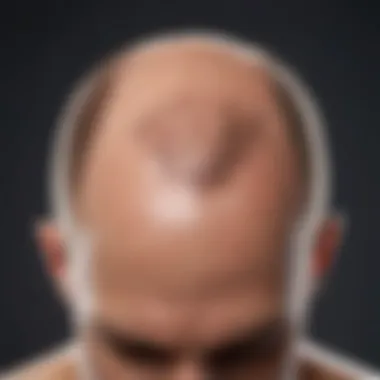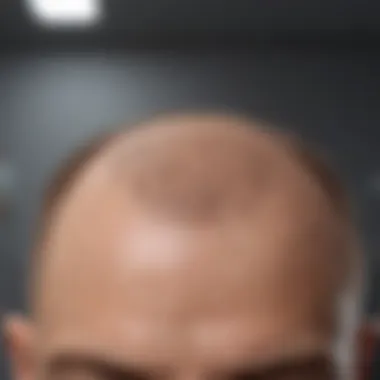Understanding the Causes of Male Balding


Intro
Balding, particularly male pattern baldness, affects a significant portion of the male population. Understanding the various factors that contribute to this condition is essential for those seeking to mitigate its effects. The causes of balding are multifaceted, involving genetic predisposition, hormonal fluctuations, environmental influences, and individual lifestyle choices. This article aims to dissect these components, providing a clear and informed perspective on the mechanisms behind hair loss in males.
Recent Advances
Latest Discoveries
Recent studies have shed light on the intricate biological processes underlying hair loss. Research indicates that androgens, particularly dihydrotestosterone (DHT), play a crucial role in the progression of male pattern baldness. DHT is derived from testosterone and is known to shrink hair follicles, leading to finer hair and eventual loss. A deeper understanding of DHT's function has led to novel approaches in treating hair loss.
In addition, genome-wide association studies have identified several key genetic markers associated with male pattern baldness. This expands the understanding of heredity, allowing for more targeted research into effective treatments.
Technological Innovations
Advancements in technology have also influenced the realm of hair restoration. Techniques such as follicular unit extraction (FUE) and robotic hair transplant systems, like the ARTAS system, offer precise and minimally invasive options for individuals looking for restoration solutions. Such innovations provide a reliable avenue for addressing the physical aspects of balding.
Methodology
Research Design
The methodology employed in researching the causes of balding involves both qualitative and quantitative analysis. This approach combines genetic research, hormonal assays, and surveys of lifestyle factors to provide a holistic view of how these elements interact to influence hair loss.
Data Collection Techniques
Data collection is primarily done through clinical studies, questionnaires, and laboratory testing. Researchers analyze genetic material, assess hormone levels, and evaluate participant lifestyle habits. This comprehensive data facilitates a deeper understanding of the patterns and predictors of male balding.
"Genetic predisposition is a significant contributor to male pattern baldness, often making it inevitable for those with a family history of hair loss."
Foreword to Male Balding
Male balding, particularly male pattern baldness, is a significant topic in the realm of men's health. Understanding the intricacies of this condition is crucial since it affects a large portion of the male population. It is not merely a cosmetic issue; it is tied to genetic, hormonal, and environmental factors that together weave a complex narrative of hair loss. By delving into this multifaceted subject, one can appreciate the biological and psychological implications that accompany it.
Defining male pattern baldness lays the foundation for a deeper exploration of causes and effects. Recognizing how widespread this condition is—rooted in genetics and hormones—offers valuable context to anyone interested. The relevance of this topic spans personal concerns and scientific inquiry.
The discussion extends beyond superficial understanding. Many men experience a dip in self-esteem due to balding, which can also affect social interactions and mental well-being. By comprehending the factors leading to hair loss, individuals may approach the issue with more clarity and possibly find empowerment through knowledge.
Defining Male Pattern Baldness
Male pattern baldness, known scientifically as androgenetic alopecia, is a progressive condition characterized by a decrease in hair density. The condition typically follows a recognizable pattern, often beginning with thinning around the temples and the crown of the head. As the condition advances, it can lead to complete baldness on the top of the head while preserving hair in areas like the sides and back. This distinctive pattern aids in diagnosing and understanding the condition.
The biological mechanisms involve an interaction between hormones, specifically androgens, and hair follicles. In essence, male pattern baldness is not simply about losing hair. It is a complex interaction of genetics and dihydrotestosterone (DHT), a derivative of testosterone, that shrinks hair follicles, resulting in finer hair strands and eventual cessation in growth.
Prevalence and Impact
The prevalence of male pattern baldness is striking. Studies suggest that approximately 50% of men experience some degree of hair loss by the age of 50. The onset can start as early as the late teenage years. The impact stretches beyond just the physical appearance.
Men facing this condition often report concerns about their self-image and the perceptions of others. Social stigma surrounding baldness can lead to significant psychological effects, including anxiety and depression. Research has indicated that individuals may engage in various coping mechanisms ranging from seeking medical intervention to adopting hairstyles that camouflage thinning areas.
In summary, the domain of male baldness warrants focused attention due to its prevalence and the complexities associated with it. By understanding the definitions and impacts, both personal and societal, there is a pathway toward more informed discussions and potentially effective measures to cope with or address this prevalent issue.
Genetic Factors
Genetic factors play a significant role in male balding, often determining the likelihood and pattern of hair loss. Understanding genetic influences is pivotal for grasping the complexity of male pattern baldness. Research repeatedly shows a hereditary tendency in this condition. The implication is clear: if there is a family history of balding, the likelihood increases substantially for subsequent generations.
Genetics can influence not just if men will bald, but also the age at which hair loss begins and the extent of it. This understanding can help in early diagnosis and potential intervention. Knowledge of one's genetic predisposition to baldness can also foster better mental health approaches. Acknowledging that hair loss is largely beyond one's control may lessen feelings of inadequacy and distress.
Hereditary Patterns of Balding
Hereditary patterns of balding often follow a predictable course in males. Typically identified as male pattern baldness, it follows a specific pattern characterized by a receding hairline and thinning at the crown. Family history is a reliable indicator; men with a family background of balding are more likely to experience it themselves.
Factors such as maternal lineage have been studied extensively. While initially believed that the X chromosome, which men inherit from their mothers, primarily drives hereditary baldness, recent research indicates that other chromosomes may also play a key role. This nuanced understanding highlights the complex interplay of multiple genetic variants.
Role of Specific Genes
The exploration of genetic factors related to hair loss continues to develop, with particular attention paid to specific genes. Researchers have identified several genes that seem to contribute to hair loss in males, notably the AR gene and BMP2 gene.
AR Gene
The AR gene, or androgen receptor gene, is centrally involved in the body's response to androgens, which include hormones like testosterone. Variations in this gene affect how hair follicles react to dihydrotestosterone (DHT), a potent derivative of testosterone linked to hair loss.
A key characteristic of the AR gene is its modulation of hair follicle sensitivity. If this gene is more active, hair follicles may become more susceptible to DHT, leading to accelerated hair thinning and loss. This gene is significant for understanding why some men experience earlier onset and more pronounced hair loss compared to others.
The unique feature of the AR gene is its direct involvement in androgen sensitivity, which varies across individuals. While variations could lead to balding, they can also result in other health implications such as prostate issues. Therefore, understanding this gene helps in providing insights into overall health and disease risk.
BMP2 Gene


The BMP2 gene, or bone morphogenetic protein 2 gene, seems to have a supporting role in hair growth regulation. This gene contributes to the development and maintenance of hair follicles. Studies suggest that BMP2 may help keep hair follicles in their growth phase, delaying the thinning process.
A distinctive aspect of BMP2 is its role in promoting the transition of hair follicles to the growth phase. This has potential implications for treatments aimed at revitalizing hair growth. However, while promoting growth, the results can be inconsistent due to individual variations in gene expression.
The understanding of BMP2’s contribution reveals potential avenues for therapeutic applications. If researchers can harness this gene's properties, there might be opportunities for developing effective hair restoration therapies. Nonetheless, the gene's complexities highlight the need for cautious optimism.
Hormonal Influences
Hormonal influences play a critical role in the biological mechanisms of male hair loss. Understanding these factors is vital for comprehending how and why balding occurs in some men while others retain a full head of hair well into old age. Hormones, especially androgens, are significant because they affect hair follicle health and density. Moreover, variations in hormone levels can lead to different hair thinning patterns among men, contributing to the complexity of male pattern baldness.
Androgens and Hair Follicle Size
Androgens are a group of hormones that include testosterone and its derivatives. These hormones are integral in regulating many physiological processes, including hair growth and development. One important aspect to consider is the relationship between androgens and hair follicle size.
- Hair follicles can range in size, and this variation can significantly influence how hair grows and the hair's eventual thickness. When androgens, like testosterone, are converted into dihydrotestosterone (DHT), they bind to androgen receptors in the hair follicles.
- The result of this binding can be the shrinkage of hair follicles, termed follicular miniaturization. Miniaturized follicles produce thinner and shorter hairs over time, leading to more noticeable hair loss.
This phenomenon is more pronounced in genetically predisposed individuals. Male pattern baldness often follows a characteristic pattern due to these hormonal impacts. The interplay between androgens and genetic makeup is pivotal for understanding who is more likely to experience hair loss.
Dihydrotestosterone (DHT) and Its Effects
Dihydrotestosterone, or DHT, is a potent androgen derived from testosterone. Its relevance in hair loss is widely acknowledged among researchers. DHT has a stronger affinity for androgen receptors in the hair follicle than testosterone itself. This affinity can lead to a variety of effects, including:
- Follicle Miniaturization: As previously mentioned, DHT can cause hair follicles to shrink. This results in hair that may still grow but is shorter and finer when compared to the original hair.
- Disruption of Hair Growth Cycle: DHT can alter the normal hair growth cycle, leading to a decrease in the anagen phase, which is the active growth phase of hair.
- Increased Hair Loss: Over time, increased levels of DHT can contribute to a higher rate of hair loss, which is often irreversible.
DHT plays a major role in hereditary baldness, making it crucial for understanding male baldness causes.
In summary, DHT’s influence on follicles underscores the need for targeted treatments for those experiencing hair loss. Treatments that inhibit DHT production or block its effects, such as Finasteride, are commonly prescribed for male pattern baldness, highlighting the link between hormonal influences and effective management strategies.
Environmental Factors
Understanding the environmental factors that contribute to balding in males is crucial for a comprehensive grasp of this condition. The influence of the surrounding environment can often be underestimated when discussing hair loss, yet it plays a significant role. Exposure to harmful elements in the atmosphere and natural factors can lead to hair health deterioration, accentuating baldness in susceptible individuals.
Impact of Pollution
Pollution is a pervasive issue that can disrupt not only our health but also the health of our hair. The air we breathe contains various pollutants, including heavy metals and particulate matter, which can take a toll on hair follicles. Studies suggest that exposure to substances like lead and mercury may contribute to hair thinning and loss.
Additionally, pollutants can create oxidative stress on the body, which damages cells including those responsible for hair growth.
- Oxidative Stress: This condition occurs when there is an imbalance between free radicals and antioxidants in the body, which results in damage to hair follicles.
- Hair Follicle Inflammation: Pollutants can lead to inflammation in the scalp, restricting blood flow and nutrient supply to hair follicles, impacting their health.
Some preventative measures against pollution's effects include:
- Using protective hair products: Shampoos and conditioners containing antioxidants can help mitigate damage caused by pollutants.
- Proper scalp care: Regular cleansing can remove build-up and impurities, promoting healthier hair.
"Pollution is not just an urban problem; its repercussions extend to various aspects of health, including hair loss."
Effect of UV Radiation
Ultraviolet (UV) radiation from the sun is another environmental factor that can adversely affect hair health. Prolonged exposure to UV rays can damage both skin and hair. The implications for hair include:
- Structural Damage: UV radiation can weaken the protein structure of hair, resulting in brittleness and a higher likelihood of breakage.
- Scalp Health: UV rays can lead to skin damage on the scalp, triggering conditions that may contribute to hair loss, such as sunburn or premature aging of skin.
To mitigate the effects of UV radiation on hair, the following strategies are effective:
- Wearing hats or scarves: Covering hair when out in the sun can provide a barrier against harmful rays.
- Using hair products with UV protection: Specialized hair care products can offer an additional layer of defense against UV damage.
Understanding how environmental factors like pollution and UV radiation contribute to balding is essential. It reveals the importance of protective measures and awareness of our surroundings, allowing for proactive management of hair health.
Lifestyle Contributions
The role of lifestyle in male balding cannot be understated. Various factors in daily living, including diet and stress, directly impact hair health. Understanding how lifestyle choices affect hair loss offers a pathway to address and possibly mitigate these effects. Awareness of personal habits can lead to improved hair health and general well-being.
Dietary Factors
Nutritional deficiencies
Nutritional deficiencies have significant implications for hair growth. A lack of essential vitamins and minerals can weaken hair follicles, resulting in increased hair shedding. Key nutrients like iron, zinc, and vitamin D play vital roles in maintaining hair strength and growth.
Without proper nutrients, hair may become fragile and thin. For instance, inadequate iron levels contribute to a condition known as telogen effluvium, where more hairs than normal enter the shedding phase. Addressing these deficiencies often leads to noticeable improvements in hair quality and quantity.
Including a balanced diet rich in vegetables, fruits, lean proteins, and whole grains can aid in preventing these deficiencies. The knowledge of how important diet is can lead to proactive measures against hair loss. This information is especially useful for those who may not consider their dietary habits in relation to hair loss.
High glycemic index foods
High glycemic index foods warrant attention in discussions about hair health. These foods, typically rich in refined sugars and carbohydrates, can lead to insulin spikes. Insulin fluctuations may contribute to increased levels of androgens, particularly dihydrotestosterone (DHT), which is closely associated with male pattern baldness.
Focusing on low glycemic index alternatives can mitigate these effects. Foods such as whole grains, legumes, and non-starchy vegetables provide stable energy without the harmful spikes associated with high glycemic options. Awareness of one’s glycemic intake may therefore be crucial for men concerned about hair loss. Striking a balance can enhance overall health and potentially slow down hair loss.


Stress and Its Psychological Effects
Stress is another critical factor influencing hair health. Mental and emotional stress triggers numerous physiological responses which may affect hair follicles directly. When under stress, the body may rapidly shed hair, leading to noticeable thinning.
Psychological stress leads to increased cortisol levels. High cortisol can disrupt the natural hair growth cycle. While some hair shedding can be a natural process, significant stress can push more hairs prematurely into the resting phase.
Understanding how stress impacts hair loss provides insight into personal well-being. Utilizing stress management techniques like mindfulness practices may contribute positively to hair health. Mental health and hair wellbeing are interconnected, and attending to one may benefit the other.
Medical Conditions Linking to Balding
Medical conditions can significantly influence the pattern and extent of hair loss in males. Understanding these medical issues is crucial for diagnosing the specific causes of balding and for developing effective treatment strategies. Some conditions may have a direct effect on hair follicle health, while others may impact overall hormonal balance or immune function, inadvertently leading to problematic hair loss. Recognizing these health connections helps identify the underlying issues contributing to baldness in men, allowing for a tailored approach in treatment.
Autoimmune Disorders
Alopecia areata
Alopecia areata is an autoimmune disorder that leads to sudden hair loss in patches. It occurs when the immune system mistakenly attacks hair follicles, disrupting the normal growth cycle of hair. One significant characteristic of this condition is its unpredictable nature; hair may regrow in one area while falling out in another. This aspect makes it a focal point in our exploration of male balding.
The relevance of alopecia areata in the context of this article lies in its distinct mechanism of action as compared to other types of hair loss. Unlike genetic or age-related hair thinning, alopecia areata is a condition rooted in immune dysfunction.
The unique feature of alopecia areata is its varying severity among individuals. For some, it may lead to complete baldness, known as alopecia totalis, while others might only experience minimal patch loss. This range highlights the unpredictable outcomes which can both challenge treatment approaches and affect psychological well-being.
Advantages of discussing alopecia areata in our article include:
- Highlighting the complexity of hair loss: It illustrates that not all hair loss is genetic or hormonal.
- Providing insights into treatment options: Discussing current therapies can inform readers about alternatives like corticosteroids or topical immunotherapy.
Thyroid Dysfunction
Thyroid dysfunction, including both hypothyroidism and hyperthyroidism, can also play a significant role in hair loss among males. The thyroid gland regulates metabolism and influences several physiological processes, including hair growth cycles. When thyroid hormone levels are imbalanced, they may lead to thinning hair or even noticeable hair loss.
Conditions such as hypothyroidism typically result in a slower metabolism and can manifest as dry, brittle hair. Conversely, hyperthyroidism can cause rapid hair loss as the body’s metabolism speeds up excessively. This broad spectrum means thyroid dysfunction represents one of several medical factors that can directly or indirectly lead to balding in males.
Addressing thyroid issues is essential not only for managing hair loss but also for overall health. Through diagnosing and treating thyroid imbalances, patients often experience improvement in hair follicles’ functionality along with other bodily health benefits, making it a pressing matter for discussion in this article.
Age-Related Changes
Age-related changes are crucial in the discussion of male balding. As men grow older, the hair growth cycle alters significantly. Understanding these changes can lead to better practices in hair care and possibly slow down the balding process. This section examines the natural aging process and the significant phenomenon known as telogen effluvium that affects older men.
Natural Aging Process
The natural aging process impacts hair in several ways. As one ages, hair follicles gradually shrink. This can lead to thinner hair and a reduction in hair density. Moreover, older men often experience an increase in hair loss. The production of hormones, particularly testosterone, changes over the years, further influencing hair quality and growth.
Some key aspects of the natural aging process include:
- Decreased hair follicle size
- Changes in hair texture and quality
- Slower regeneration cycles for hair
These changes can result in noticeable thinning across the scalp. Many men might notice increased hair shedding, especially during the late thirties and into their forties. The body's ability to regenerate hair diminishes with age, leading to different patterns of hair loss as well.
Telogen Effluvium in Older Men
Telogen effluvium is a specific form of hair loss that can occur in older men. It is characterized by increased shedding of hair and is often the result of stress, disease, or a significant life change. This condition is temporary but can impact self-esteem for those experiencing it. The cyclical nature of hair growth means that as some hairs enter the resting phase, they can fall out more easily.
Factors leading to telogen effluvium in older men include:
- Physical stress such as surgery or illness.
- Emotional stress from significant life events.
- Nutritional deficiencies that may arise due to aging.
"Telogen effluvium generally reverses once the underlying issue is resolved, but identifying the cause is essential for recovery."
Recognizing that telogen effluvium might be temporary can provide relief. However, older men might still seek treatment or methods to manage appearance and regain confidence during this period. Understanding both the natural aging process and telogen effluvium allows for a more comprehensive grasp of balding in males as they age.
Psychosocial Aspects
The psychological and social dimensions of balding in males are essential yet frequently overlooked components of the broader discussion around this condition. Recognizing the psychosocial aspects of hair loss can enhance our understanding of its impact not only on individual lives but also on societal perceptions. Hair is often associated with youth, vigor, and attractiveness. Therefore, losing one's hair can instigate feelings of insecurity, anxiety, and low self-worth. This section aims to unravel the intricate relationship between balding and psychological well-being, while also examining the societal implications attached to it.
Self-Esteem and Identity
Balding can have profound effects on self-esteem and identity. For many men, hair is a key part of personal expression and can influence how they perceive themselves. The experience of hair loss can lead to a diminishment of self-image.
Numerous studies have shown that men who experience balding may feel less confident in social situations, which can significantly alter interaction patterns. In some cases, hair loss can lead to withdrawal from social events, fearing negative judgments from peers.
- Feelings of inadequacy: Many men might compare themselves to societal norms regarding appearance, often leading to a diminished sense of masculinity when these norms are not met.
- Identity crises: Some individuals may undergo what could be termed an 'identity crisis,' as they struggle to reconcile their changing appearance with their previously held self-image.
These feelings manifest in both personal and professional environments. A decline in self-esteem can inhibit career opportunities, as confidence often plays a critical role in professional advancement. Thus, addressing the psychological ramifications of hair loss is important in providing comprehensive care and support.
Social Stigma Associated with Hair Loss


The social stigma surrounding hair loss is another critical element in this narrative. Males often face societal pressure that perpetuates negative stereotypes about baldness. This stigma can lead to numerous challenges in daily life.
- Perceptions of aging: Society often equates baldness with aging and, in turn, with decreased vitality. This perception can lead to social isolation as individuals may fear judgment for their appearance.
- Mockery and teasing: Further compounding this issue is the prevalence of ridicule. Male pattern baldness is sometimes the subject of jokes and derision, particularly in youth. Such experiences can lead to lasting psychological harm.
Despite these challenges, a gradual shift in societal attitudes towards baldness has emerged. The increasing visibility of bald public figures, alongside campaigns promoting acceptance of various appearances, can aid in reducing stigma. Yet, there remains a long road ahead in fostering environments where individuals can embrace their changing appearance without malicious scrutiny.
"Understanding the psychosocial dimensions of male balding can equip individuals and society with the necessary knowledge to address the psychological impacts and promote a healthier perspective about hair loss."
In summary, focusing on the psychosocial aspects of balding allows for a deeper insight into how this condition is experienced by men. By recognizing the importance of self-esteem and the social stigma associated with hair loss, we can better understand the challenges faced by those experiencing this common condition.
Preventative Measures
Preventative measures offer a proactive approach to managing male balding. They can help mitigate the onset of hair loss or slow its progression. Understanding these strategies is vital for men experiencing or at risk of baldness. Knowing what actions might reduce the impact of baldness can empower individuals in their hair care journey. This section will focus on critical elements of preventative measures, their benefits, and considerations that should not be overlooked.
Early Interventions
Identifying signs of hair loss early can be crucial. Men should regularly monitor their hair's density and assess changes that could indicate an issue. Early intervention often leads to more successful outcomes. Options for early interventions include:
- Topical Treatments: The use of minoxidil can stimulate hair growth. Starting this as soon as thinning is recognized may improve results.
- Medications: Finasteride blocks the formation of dihydrotestosterone (DHT). It is effective in slowing hair loss when taken early.
- Consultation with Dermatologists: A professional can assess the extent of the issue and recommend suitable treatments tailored to individual needs.
"Intervention in the initial stages of hair loss can be significantly more effective than waiting until extensive thinning occurs."
These strategies will require commitment, but they can potentially preserve hair for years.
Nutritional Supplements and Their Efficacy
Diet plays a significant role in overall health and, by extension, hair health. Nutritional supplements can combat deficiencies that may contribute to hair loss. Key supplements to consider include:
- Biotin: Known as vitamin B7, biotin supports keratin production and may enhance hair strength.
- Vitamin D: It plays a role in the hair growth cycle. Low levels are connected to increased hair shedding.
- Zinc: This mineral is essential for tissue growth and repair. Insufficient zinc levels can lead to hair loss.
- Omega-3 Fatty Acids: Found in fish oil, these can improve hair thickness and increase growth rates.
When considering using supplements, it is essential to consult with a healthcare provider. They can provide guidance on appropriate dosages and confirm whether specific supplements are suitable based on individual health conditions. The efficacy of supplements can vary widely, thus, informed choices are important.
Treatment Options
The topic of treatment options for male balding is essential in understanding how to manage this condition. Men experiencing hair loss often seek effective ways to either reverse or slow down the process. Discussing available treatments is pertinent for both psychological relief and practical solutions. Treatment options can broadly be categorized into medications and surgical methods, which each offer distinct benefits and considerations that can impact a man’s decision.
Medications and Their Mechanisms
Finasteride
Finasteride is a well-known medication for the treatment of male pattern baldness. It primarily works by inhibiting the enzyme 5-alpha-reductase, which is responsible for the conversion of testosterone to dihydrotestosterone (DHT). This DHT is a key contributor to hair follicle miniaturization. A key characteristic of Finasteride is its oral administration, allowing for convenient daily use. Many regard it as a beneficial choice as it can significantly slow hair loss and even promote regrowth in some individuals.
However, it is important to note that Finasteride can have side effects, including sexual dysfunction, which may deter some from using it. Additionally, the medication must be taken continuously; discontinuation can lead to a reversal of any gains achieved during treatment.
Minoxidil
Minoxidil is another popular option, typically available as a topical solution or foam. Originally developed as a treatment for high blood pressure, its hair-growing properties became apparent during clinical use. Minoxidil works by increasing blood flow to hair follicles, which can stimulate hair growth and thicken existing hair. Its main advantage is that it can be applied directly to the scalp, making it easy to use.
Patients often find Minoxidil effective, particularly in the early stages of hair loss. However, results can vary, and it usually takes several months to notice any improvement. Side effects may include scalp irritation and unwanted hair growth in areas other than the scalp if not applied carefully.
Surgical Approaches
Hair Transplants
Hair transplants are a surgical solution that provides long-term results for those seeking to restore hair. This procedure involves relocating hair follicles from a donor site, usually the back of the head, to balding areas. A key characteristic of hair transplant techniques, like Follicular Unit Transplantation (FUT) and Follicular Unit Extraction (FUE), is their capacity for natural-looking results. Many men opt for this surgery as it can lead to permanent hair restoration.
Nonetheless, this approach can be costly and may require multiple sessions for optimal results. A potential drawback includes the healing time post-surgery, where patients may experience discomfort and swelling in the donor and recipient sites.
Scalp Micropigmentation
Scalp Micropigmentation is a non-surgical option that involves depositing pigments onto the scalp to create the appearance of hair follicles. This technique offers a unique feature in providing an instant visual improvement to individuals experiencing thinning hair or baldness. Often seen as a cosmetic solution, Scalp Micropigmentation can enhance an individual’s confidence without the need for invasive procedures.
Though it does not promote hair regrowth, its advantages lie in its affordability compared to surgical options and minimal recovery time. However, results may require touch-ups over the years to maintain the appearance, as fading can occur.
Investing in a suitable treatment option is a personal journey for many men. Balancing efficacy, budget, and personal comfort with potential side effects is crucial.
The End
The conclusion of an article about male balding holds significant importance. It serves as a summative section where the reader can reflect on the key themes discussed throughout the text. Engaging with the complexities of hair loss offers a valuable perspective into a widespread concern. Understanding these various causes emphasizes the multi-faceted nature of balding—what might seem purely genetic or age-related often intertwines with lifestyle, hormonal changes, and even environmental factors.
Summarizing Key Points
In this comprehensive analysis, we have explored many aspects of male balding, including:
- Genetic Factors: Hereditary patterns play a crucial role in determining susceptibility. Specific genes, like the AR and BMP2 genes, have shown significant links to hair loss.
- Hormonal Influences: The relationship between androgens, especially Dihydrotestosterone (DHT), and hair follicle dynamics is well-documented and illustrates how hormonal changes can directly impact hair growth.
- Environmental Factors: Factors such as pollution and UV radiation have been shown to cause damage to hair follicles, adding another layer of complexity to the discussion of hair loss.
- Lifestyle Contributions: Diet and stress levels can exacerbate hair loss. Nutritional deficiencies and excessive stress create a compounded issue that may accelerate baldness.
- Medical Conditions: Illnesses, including autoimmune disorders like alopecia areata and thyroid dysfunctions, present additional health concerns that relate to hair loss.
- Psychosocial Aspects: Social stigma affects self-esteem. Recognizing this can help facilitate discussions around mental health for individuals experiencing hair loss.
- Preventative Measures and Treatment Options: Healthy practices and medical interventions exist. From early interventions to medications such as Finasteride and Minoxidil, understanding available solutions is crucial for those affected.
Future Research Directions
The exploration of male balding is an ongoing endeavor with many potential avenues for further inquiry. Future studies could focus on:
- Longitudinal Studies: More extended studies examining the impact of environmental factors and lifestyle choices over time could reveal valuable insights into preventive strategies.
- Genetic Research: Continued investigation into the genetic components of balding may yield new therapeutic targets, further clarifying how inherited traits manifest biologically.
- Hormonal Studies: Research into the role of hormones beyond DHT might uncover other contributors to hair loss, providing a more robust understanding of its biological mechanisms.
- Psychological Impact: Investigations into how society views baldness and its effects on psychological well-being will enrich the psychosocial understanding of baldness.
Overall, this article seeks to enhance understanding regarding male balding while promoting thoughtful discussions around this significant concern. A comprehensive overview of the causes, implications, and potential solutions provides a foundational knowledge base for both affected individuals and the medical community.















